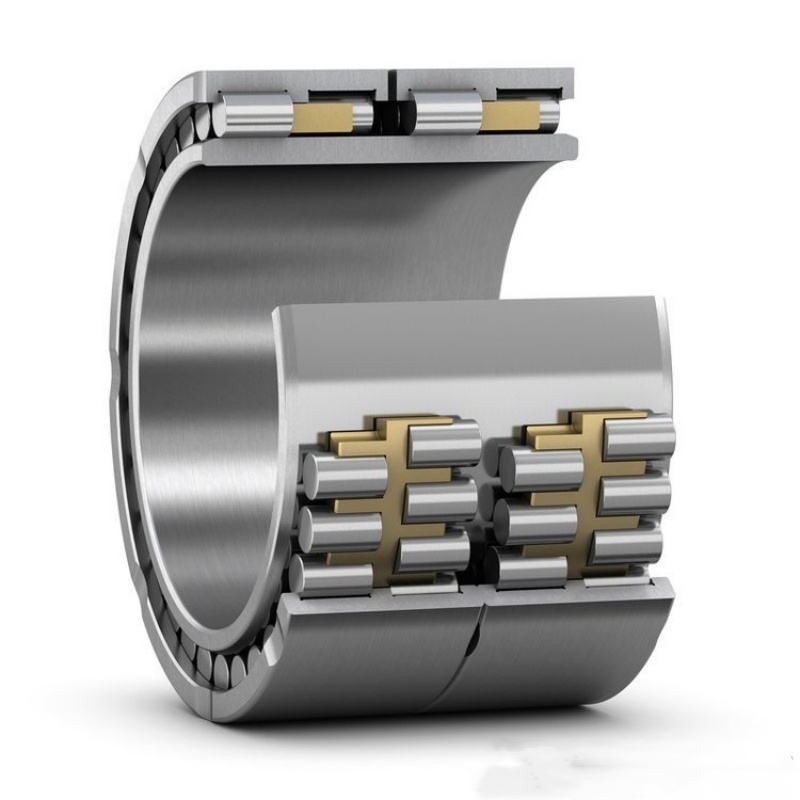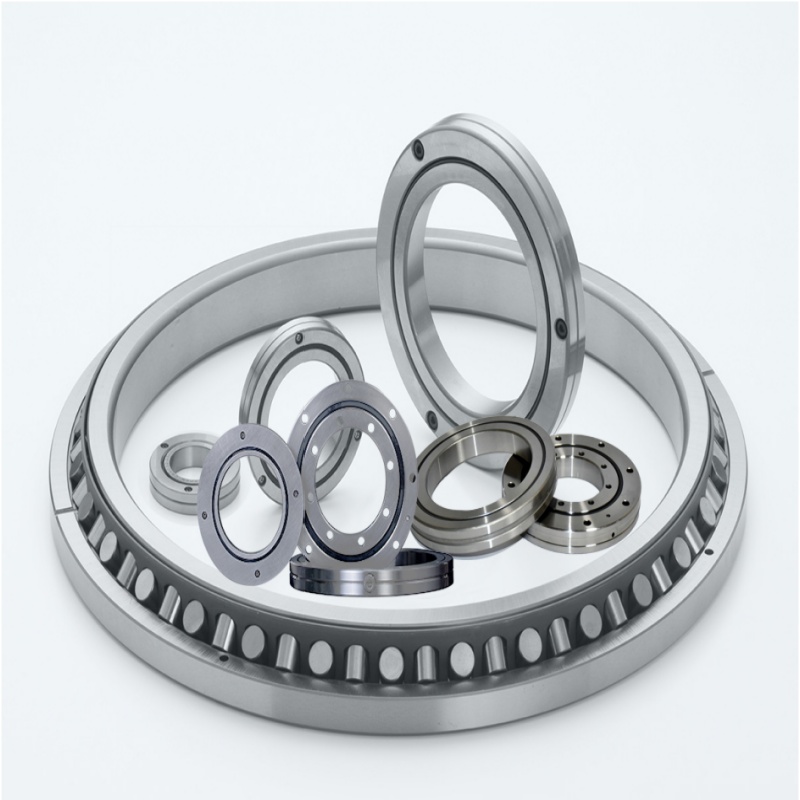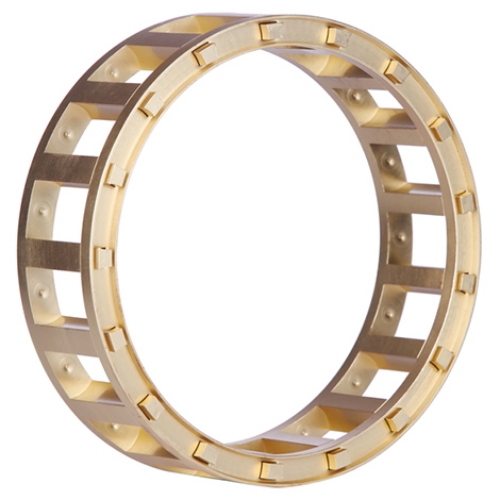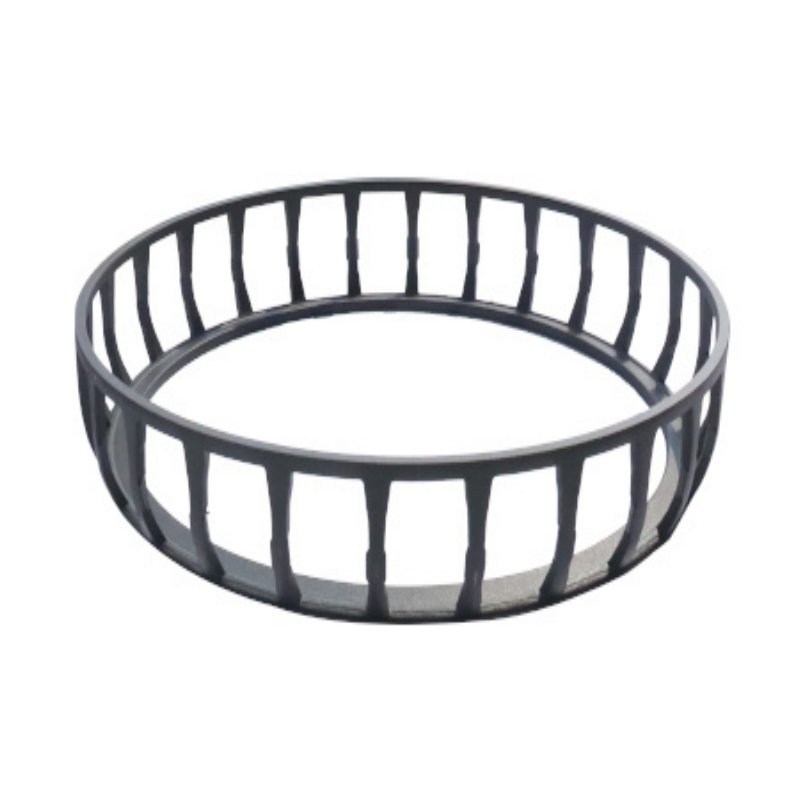What Is a Cross Roller Bearing?
Sep 29,2025
A
cross roller bearing, also known as a crossed-roller bearing, is a high-performance precision bearing with unique structural design. It mainly uses cylindrical rollers or conical rollers as rolling elements, which are arranged crosswise on a single raceway and separated by retainers or spacers. Its core advantage lies in integrating high rotational precision, large load-carrying capacity, compact external dimensions, high rotational speed, and strong rigidity into one, making it capable of withstanding radial, axial, and moment loads simultaneously. As a professional manufacturer of cross roller bearings, NEWBEE Transmission relies on advanced structural design and high-quality material selection. Under complex working conditions such as high speed, heavy load, and high precision requirements, its cross roller bearings can reduce equipment vibration by 10%-15% and extend the service life of mechanical equipment to 1.2 times that of ordinary bearings. These bearings are widely compatible with industrial robots, machine tools, medical equipment, and other fields, fully demonstrating in-depth technical mastery of precision bearing manufacturing.
Features of Cross Roller Bearings
- Multi-directional Load-Bearing Capacity: The crosswise arrangement of rollers enables the bearing to efficiently bear radial, axial, and moment loads at the same time. The line contact between the rollers and the raceway (V-shaped 90° groove between inner and outer rings) maximizes the load-bearing area. Even with a small external size, it can withstand large loads, which is 30% higher than the load-bearing capacity of ordinary precision bearings of the same size.
- High Precision and Rigidity: Through precision cold ring rolling and super-fine grinding processes, the tolerance of NEWBEE Transmission's cross roller bearings can reach P5/P4 level. The high-rigidity structural design ensures minimal deformation during high-speed rotation, controlling the radial runout to ≤0.005mm. This meets the high-precision operation requirements of equipment such as precision measuring instruments and semiconductor lithography machines.
- Compact Structure and Space-Saving: The integrated design of inner and outer rings (for RU and CRBH series) or split structure (for RB and SXU series) effectively reduces the overall volume of the bearing. The ultra-thin cross-section design (minimum cross-section height of CRBH series is extremely small) saves 20%-25% of installation space compared with traditional combined bearing solutions, making it suitable for equipment with strict space constraints.
- Strong Environmental Adaptability: According to different application scenarios, targeted material selection and lubrication solutions are adopted. For high-temperature environments, high-temperature resistant materials and lubricants are used; for heavy-load conditions, high-strength alloy steel rings are selected. The bearings can operate stably in environments with temperatures ranging from -20℃ to 150℃, and the service life is not easily affected by harsh conditions such as vibration and impact.
- Low Friction and High-Speed Performance: The reasonable design of retainers and the optimization of roller spacing reduce the friction between rolling elements. Under the condition of 3000rpm, the friction coefficient is as low as 0.0015, and the power loss is 18% lower than that of ordinary roller bearings. This ensures the bearing maintains high rotational speed while reducing heat generation, adapting to the high-speed operation needs of machine tool spindles and aviation equipment.
Main Types of Cross Roller Bearings
Based on structural design, application scenarios, and performance requirements, cross roller bearings can be divided into multiple series. NEWBEE Transmission provides a full range of cross roller bearing types to meet the needs of different fields:
- RA Series Cross Roller Bearings: Adopt orthogonal arrangement of cylindrical rollers, which can efficiently bear radial, axial, and moment loads. The compact structure and high-rigidity design make it particularly suitable for industrial equipment with strict requirements on installation space and rigidity, such as rotating parts of industrial robots.
- RB Series Cross Roller Bearings: Feature a split outer ring and rotating inner ring structure. The orthogonal layout of cylindrical rollers ensures stable load transmission. Its high-rigidity and high load-bearing performance make it widely used in machine tool rotary tables and precision indexing mechanisms.
- RU Series Cross Roller Bearings: Integral design of inner and outer rings, with built-in lubrication holes and mounting holes. The integrated structure simplifies the installation process, and the built-in lubrication holes facilitate regular maintenance. It is suitable for equipment that requires convenient installation and maintenance, such as medical imaging equipment.
- SXU Series Cross Roller Bearings: Have an integral inner ring and split outer ring structure. The orthogonal roller arrangement achieves high rigidity support, and the ultra-thin cross-section design further saves installation space. It is mainly used in precision equipment with ultra-small installation space, such as micro-precision measuring instruments.
- CRBH Series Cross Roller Bearings: Integral design of inner and outer rings, with ultra-thin cross-section. Through orthogonal roller layout, it can bear multi-directional loads. The minimum cross-section height is extremely small, which is the first choice for equipment with extremely strict space requirements, such as semiconductor etching machines.
Application Fields of Cross Roller Bearings
As a high-precision and high-performance bearing, the type and specification of cross roller bearings need to be accurately matched with the application scenario. Various cross roller bearings of NEWBEE Machinery have been widely used in multiple fields:
- Industrial Robotics Field: Provide high-precision rotational support for the joint movements of industrial robots. They can effectively handle various forces in complex working conditions, improving the movement precision and stability of robot joints. The RA and RB series bearings are commonly used, ensuring the robot's repeated positioning accuracy is within ±0.01mm.
- Machine Tool Industry: Play a crucial role in the spindle systems and rotary tables of machine tools. During high-speed rotation, they bear radial, axial loads, and overturning moments, ensuring the high precision of machined parts. The P4-level RU series bearings are suitable for high-speed and high-precision machine tools, controlling the machining error of workpieces to ≤0.003mm.
- Precision Measuring Instruments Field: Support the rotating parts of precision measuring instruments (such as coordinate measuring machines). By bearing radial and axial forces, they achieve precise movement of the instruments, ensuring measurement accuracy. The SXU series bearings with ultra-thin cross-section are widely used here, meeting the miniaturization and high-precision requirements of measuring instruments.
- Medical Equipment Field: In medical imaging equipment such as CT scanners and MRI machines, they support rotating components to ensure high precision and stability during image acquisition, thus obtaining accurate medical images. The CRBH series bearings with compact structure and low noise are the preferred choice, and their operating noise is ≤50dB, avoiding interference with medical equipment.
- Aviation Field: Play a critical role in aircraft landing gear systems and engine components. They can handle high impact forces during aircraft landing, takeoff, and taxiing, ensuring smooth operation of the equipment. High-strength RA series bearings are used, which can withstand instantaneous impact loads of 1.5 times the rated load without damage.
- Semiconductor Field: In semiconductor manufacturing equipment such as lithography machines and etching machines, they support the worktables, enabling precise movement and positioning of the worktables with high accuracy. The P5-level CRBH series bearings are used, controlling the positioning error of the worktable to ≤0.002mm, ensuring the quality of semiconductor chip manufacturing.
Factors Affecting the Price of Cross Roller Bearings
The price of cross roller bearings is affected by factors such as material selection, precision level, structural complexity, and customization requirements. NEWBEE Transmission can provide a transparent quotation plan to help users accurately control costs:
- Material Differences: The material of inner and outer rings and rollers directly affects the price. Bearings made of high-strength alloy steel (such as GCr15SiMn) are 20%-30% more expensive than those made of ordinary carbon steel. For bearings used in high-temperature or corrosive environments, special materials such as stainless steel or high-temperature alloys are used, and the price can be 50%-80% higher than that of ordinary alloy steel bearings.
- Precision Level: Higher precision bearings require more complex processing processes and stricter quality control. P4-level cross roller bearings are 40%-50% more expensive than P5-level ones; P2-level precision bearings (for ultra-high-precision equipment) are even 2-3 times more expensive than P4-level ones. The increase in precision is accompanied by the improvement of processing equipment and inspection standards, which increases the production cost.
- Structural Complexity: Split structure bearings (such as RB series with split outer ring) require more complex processing and assembly processes than integral structure bearings (such as RU series), so the price is 15%-20% higher. Bearings with special designs such as built-in lubrication holes and mounting holes (RU series) also increase the processing difficulty, leading to a 10%-15% price increase compared with ordinary structural bearings.
- Customization Requirements: Customized bearings for special application scenarios (such as high-temperature, high-speed, or ultra-large size) require redesign of structures, development of special molds, and adjustment of production processes. The price of small-batch customized products (<50 sets) is 30%-50% higher than that of standard products. Special surface treatments (such as anti-rust coating) will also increase the cost by 10%-15%.
- Order Quantity: Bulk orders can enjoy significant price discounts. The unit price of orders with a quantity of more than 1000 sets is 15%-20% lower than that of small-batch orders (<100 sets). This is because mass production reduces the cost of mold debugging, raw material procurement, and production management.
What Factors Should Be Considered When Purchasing Cross Roller Bearings?
- Match Working Conditions with Bearing Type: Select the appropriate series according to the load type, rotational speed, and installation space. For heavy-load and high-rigidity requirements, choose RA or RB series; for space-constrained scenarios, select CRBH or SXU series with ultra-thin cross-section; for high-speed operation, prioritize RU series with low friction. NEWBEE Machinery can recommend the most suitable bearing type based on working condition parameters to avoid performance waste or insufficient load-bearing capacity.
- Confirm Precision Level Requirements: According to the equipment's precision requirements, select the corresponding tolerance level. Precision measuring instruments and semiconductor equipment usually require P4 or P2 level; ordinary industrial robots and machine tools can choose P5 level. When purchasing, request precision inspection reports (such as dimensional tolerance, runout error data) from the supplier to ensure the bearing meets the equipment's precision standards.
- Pay Attention to Material and Lubrication Solutions: For special environments, confirm the bearing material and lubricant type. In high-temperature environments, ensure the bearing uses high-temperature resistant materials and lubricants; in humid or corrosive environments, select stainless steel bearings or bearings with anti-rust coating. Improper material selection will reduce the bearing's service life by 50% or more.
- Verify Supplier Qualifications and Quality Assurance: Choose suppliers with complete production chains and strict quality control, such as NEWBEE Transmission. They can provide material inspection reports, performance test data (such as load-bearing capacity, service life), and after-sales technical support. Avoid purchasing products from unqualified suppliers, as inferior bearings may have problems such as uneven roller spacing and substandard material strength, leading to equipment failure.
- Balance Cost and Performance: When comparing quotations, comprehensively consider the bearing's performance, service life, and maintenance cost, rather than just the initial purchase price. Although high-precision and high-quality bearings have higher initial costs, they can reduce equipment maintenance frequency and downtime loss, which is more cost-effective in the long run. NEWBEE Transmission can provide cost-effective solutions based on the user's budget and performance requirements.
A High-Quality Supplier of Cross Roller Bearings - NEWBEE Transmission
NEWBEE Transmission is a professional manufacturer of cross roller bearings with 20 years of experience in customized machinery parts. It provides a full range of cross roller bearing series, including RA, RB, RU, SXU, and CRBH, suitable for equipment with inner diameter requirements ranging from a few millimeters to hundreds of millimeters. It can also customize bearing structures, material selection, and lubrication solutions according to customer needs.
Relying on advanced manufacturing equipment and strict quality control, NEWBEE Transmission achieves high precision in the production process of cross roller bearings: fully automatic
CNC machine tools and high-precision grinding equipment ensure the processing accuracy of inner and outer rings; the MES system monitors the production progress in real time, and the entire order process is traceable. Combined with the ISO 9001 quality management system, each batch of bearings undergoes 100% full-process quality control: raw materials are double-verified by spectral analyzers and metallographic microscopes; key dimensions are monitored online by profilometers and roundness testers; noise levels, vibration values, and service life are fully inspected; durability tests are carried out under simulated working conditions.
Currently, NEWBEE Transmission's cross roller bearings have been widely used in global industrial fields. The RA and RB series bearings occupy a significant market share in the industrial robot and machine tool industries; the CRBH and SXU series bearings are favored by customers in the semiconductor and medical equipment fields.
For detailed parameters of cross roller bearings (such as dimensional specifications, load-bearing capacity), customization plans, or quotations, you can contact the technical team of NEWBEE Machinery directly.
Precautions for the Use and Maintenance of Cross Roller Bearings
- Standard Installation Operation: During installation, ensure the coaxiality deviation between the bearing, shaft, and housing is ≤0.05mm. Avoid forcibly striking the bearing with hammers or other tools to prevent damage to the inner and outer rings and rollers. For split structure bearings (such as RB series), follow the correct assembly sequence to ensure the split parts are tightly fitted and the rollers are evenly distributed. NEWBEE Transmission provides installation guides to help users avoid installation errors.
- Regular Lubrication and Maintenance: According to the bearing's working conditions and lubricant type, formulate a regular lubrication plan. For general working conditions, lubricate every 300-500 operating hours; for high-speed or high-temperature conditions, shorten the lubrication interval. Ensure the lubricant fills the gap between the rollers and the raceway, but do not overfill (the filling amount is 1/2-2/3 of the bearing's internal space) to avoid increasing friction and heat generation.
- Cleaning and Protection: Before installation, clean the bearing surface and installation parts to remove oil stains, impurities, and dust. During use, install protective devices (such as dust covers, seals) to prevent external impurities from entering the bearing, which may cause wear of rollers and raceways and reduce service life.
- Regular Inspection and Replacement: During daily operation, monitor the bearing's temperature, vibration, and noise. If abnormalities occur (such as temperature rise >15℃, obvious increase in vibration or noise), shut down the machine immediately for inspection. Every 1000-2000 operating hours, disassemble the bearing for comprehensive inspection, including checking the wear of rollers and raceways, the integrity of retainers, and the condition of lubricants. When the bearing is severely worn, deformed, or has cracks, replace it promptly to avoid equipment failure.
For the latest prices of cross roller bearings, customization plans, or technical materials (including installation guides and maintenance manuals), please contact NEWBEE Transmission:
Email: Tom@newbeetrans.com




